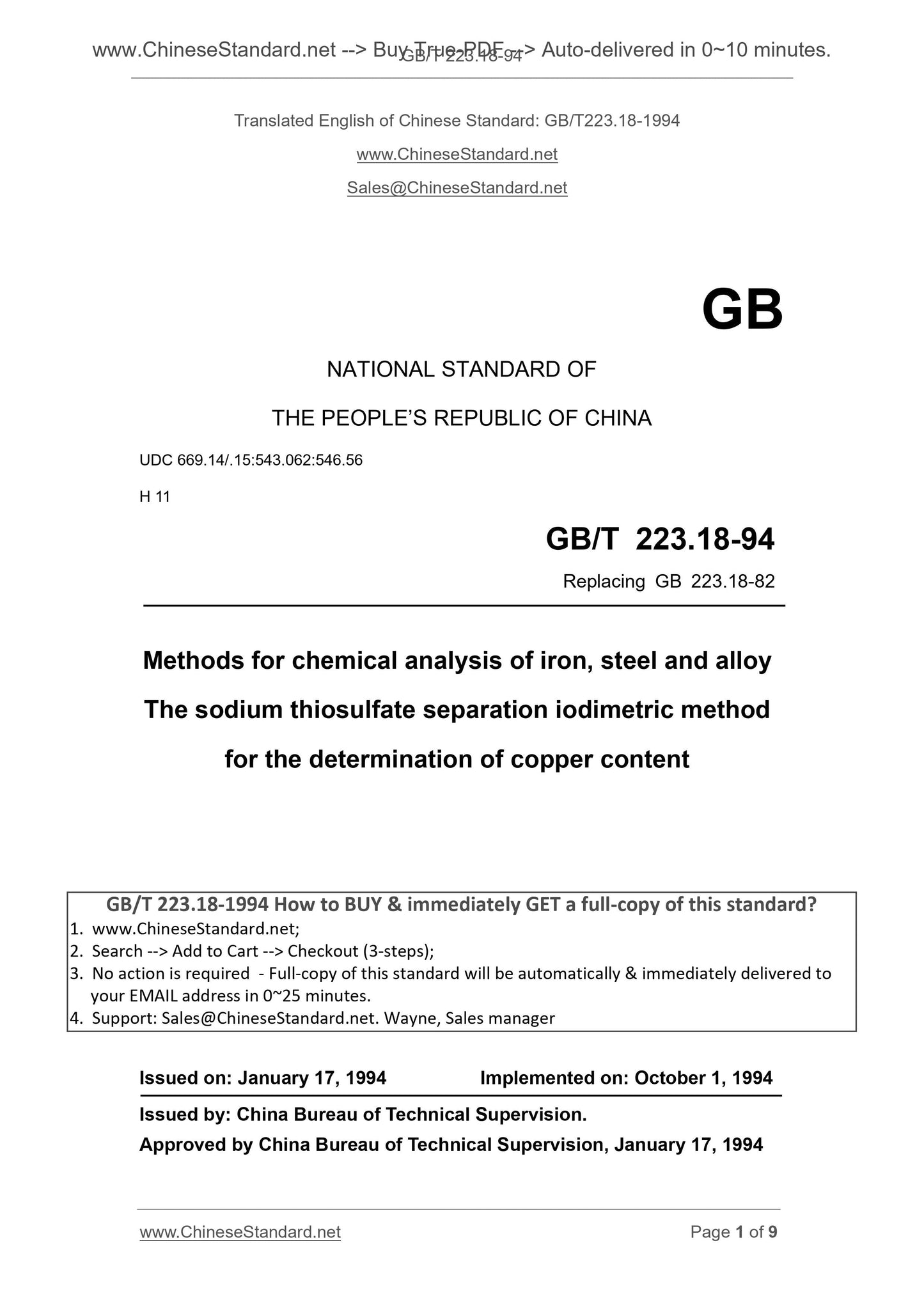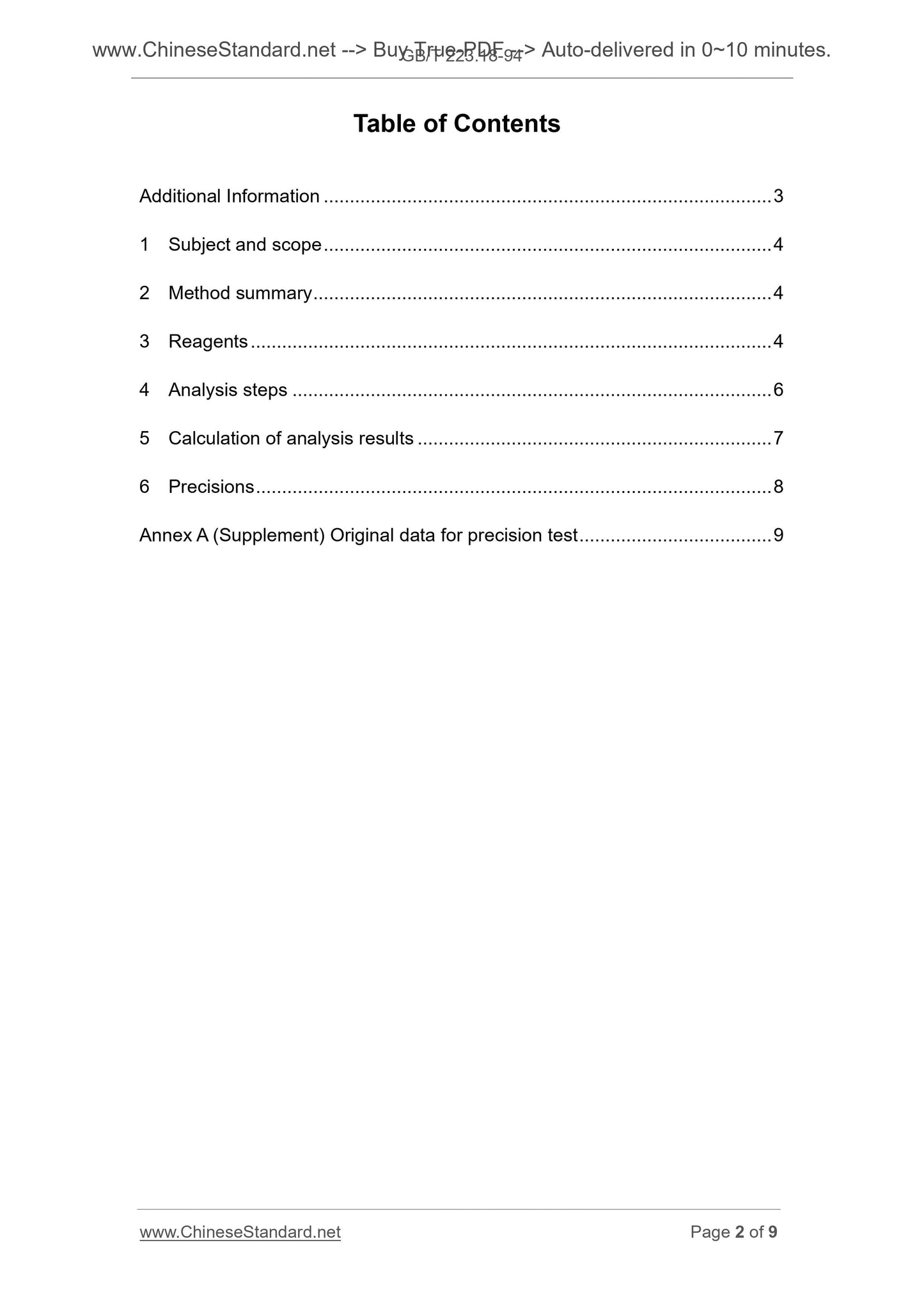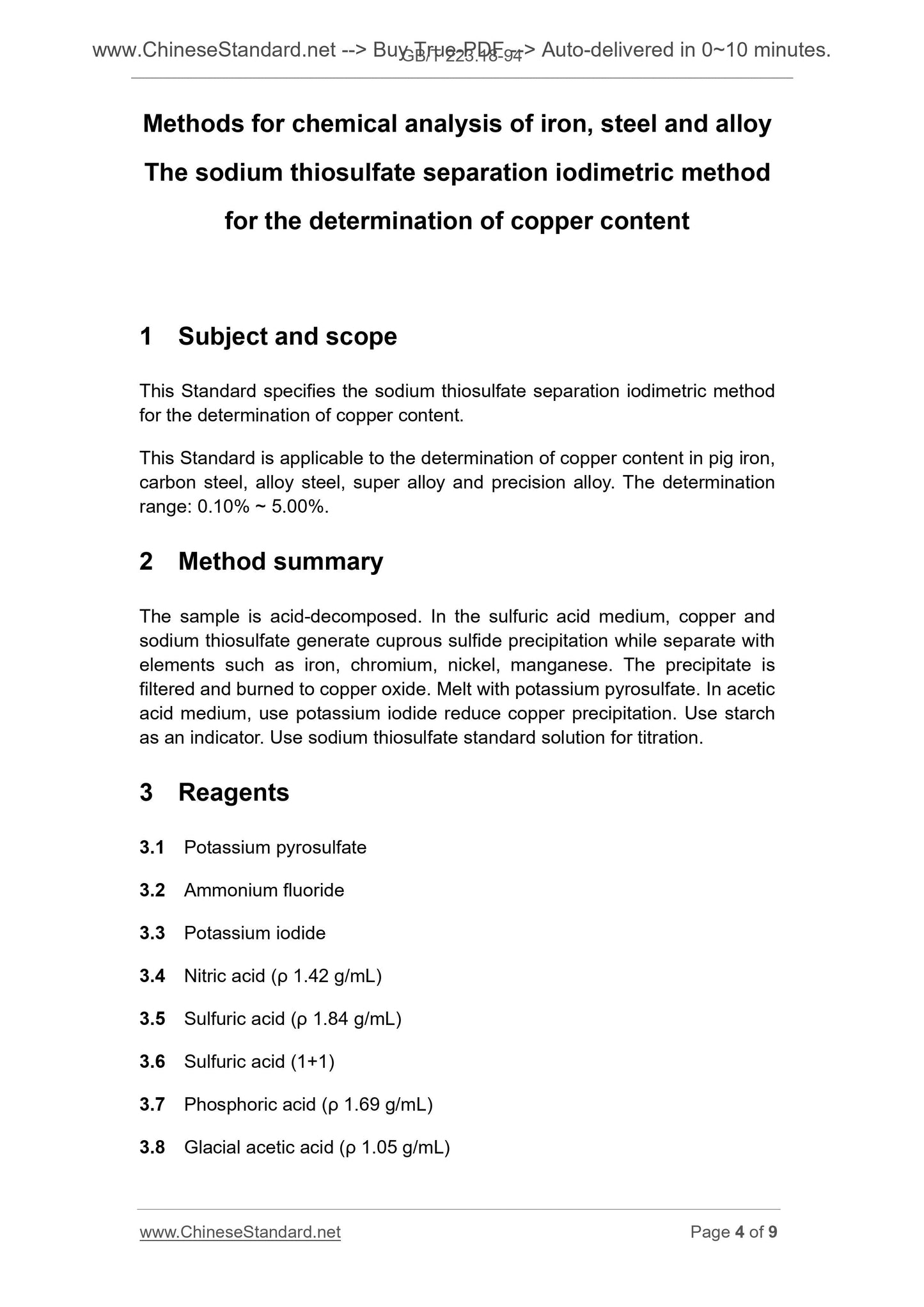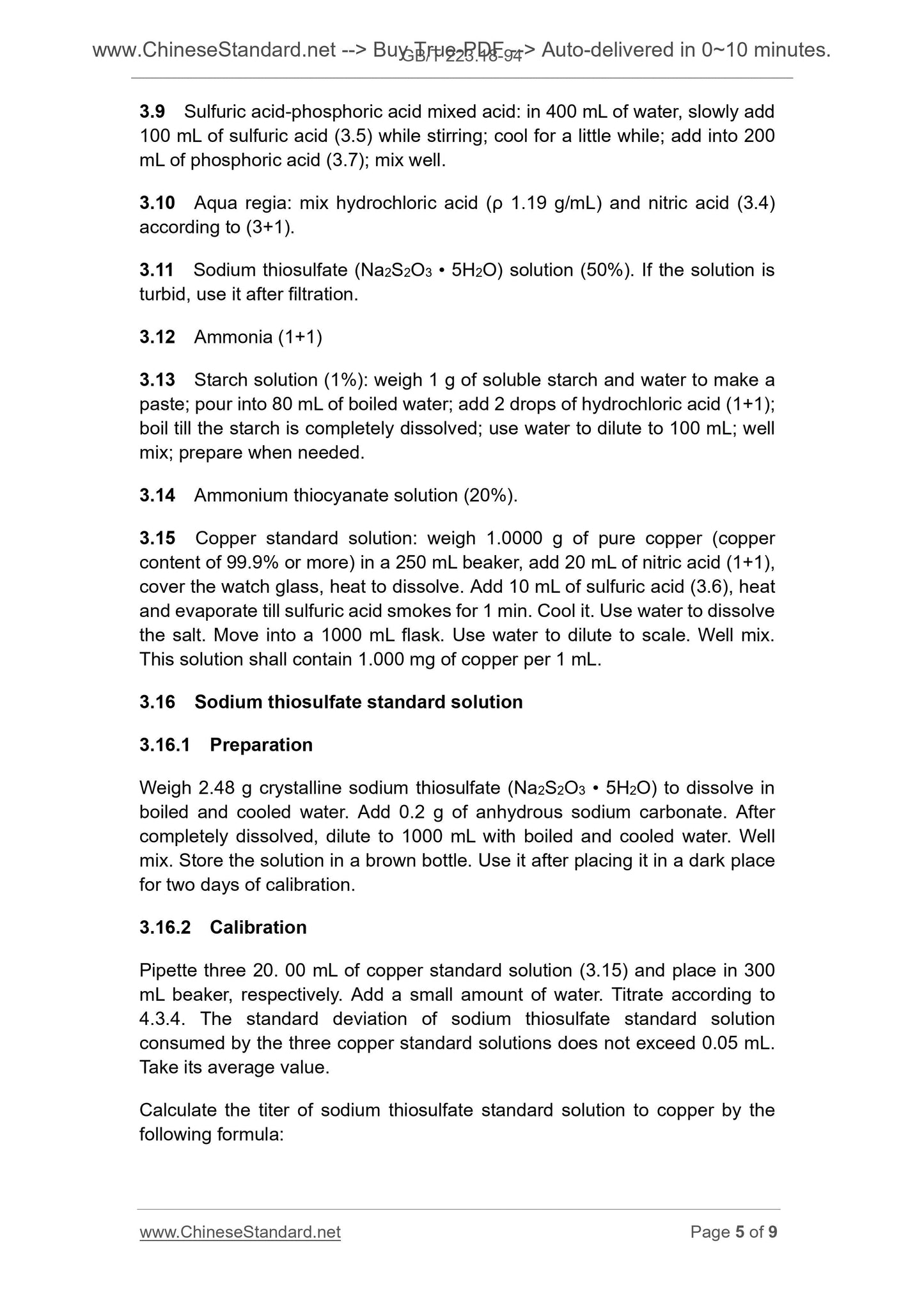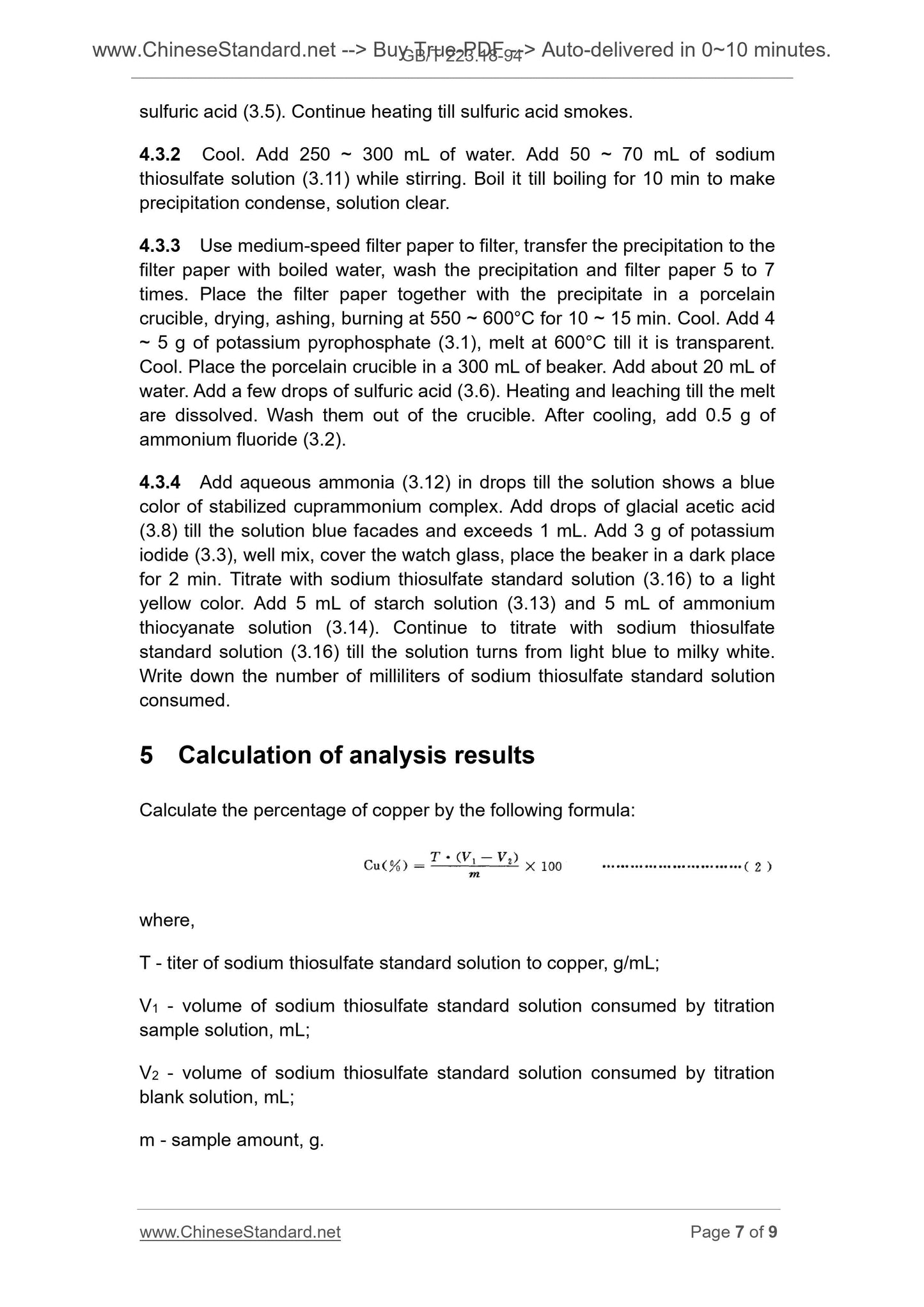1
/
of
5
PayPal, credit cards. Download editable-PDF and invoice in 1 second!
GB/T 223.18-1994 English PDF (GB/T223.18-1994)
GB/T 223.18-1994 English PDF (GB/T223.18-1994)
Regular price
$70.00 USD
Regular price
Sale price
$70.00 USD
Unit price
/
per
Shipping calculated at checkout.
Couldn't load pickup availability
Delivery: 3 seconds. Download true-PDF + Invoice.
Get QUOTATION in 1-minute: Click GB/T 223.18-1994
Historical versions: GB/T 223.18-1994
Preview True-PDF (Reload/Scroll if blank)
GB/T 223.18-1994: Methods for chemical analysis of iron steel and alloy - The sodium thiosulfate separation iodometric method for the determination of copper content
GB/T 223.18-94
GB
NATIONAL STANDARD OF
THE PEOPLE’S REPUBLIC OF CHINA
UDC 669.14/.15.543.062.546.56
H 11
Replacing GB 223.18-82
Methods for chemical analysis of iron, steel and alloy
The sodium thiosulfate separation iodimetric method
for the determination of copper content
ISSUED ON. JANUARY 17, 1994
IMPLEMENTED ON. OCTOBER 1, 1994
Issued by. China Bureau of Technical Supervision.
Approved by China Bureau of Technical Supervision, January 17, 1994
Table of Contents
Additional Information ... 3
1 Subject and scope ... 4
2 Method summary ... 4
3 Reagents ... 4
4 Analysis steps ... 6
5 Calculation of analysis results ... 7
6 Precisions ... 8
Annex A (Supplement) Original data for precision test ... 9
Additional Information
This Standard was proposed by Ministry of Metallurgical Industry of People's
Republic of China.
Main drafting organization of this Standard. Metallurgical Industry Research
Institute of Iron and Steel.
The drafting organizations of this Standard. Ministry of Metallurgical Industry
Institute of Wuhan Iron and Steel Company, Beijing Iron and Steel Research
Institute.
Main drafters of this Standard. Cao Hongyan, Ke Ruihua, Zhang Wenrong.
This Standard’s level mark is. GB 223.18 Y
Methods for chemical analysis of iron, steel and alloy
The sodium thiosulfate separation iodimetric method
for the determination of copper content
1 Subject and scope
This Standard specifies the sodium thiosulfate separation iodimetric method
for the determination of copper content.
This Standard is applicable to the determination of copper content in pig iron,
carbon steel, alloy steel, super alloy and precision alloy. The determination
range. 0.10% ~ 5.00%.
2 Method summary
The sample is acid-decomposed. In the sulfuric acid medium, copper and
sodium thiosulfate generate cuprous sulfide precipitation while separate with
elements such as iron, chromium, nickel, manganese. The precipitate is
filtered and burned to copper oxide. Melt with potassium pyrosulfate. In acetic
acid medium, use potassium iodide reduce copper precipitation. Use starch
as an indicator. Use sodium thiosulfate standard solution for titration.
3 Reagents
3.1 Potassium pyrosulfate
3.2 Ammonium fluoride
3.3 Potassium iodide
3.4 Nitric acid (ρ 1.42 g/mL)
3.5 Sulfuric acid (ρ 1.84 g/mL)
3.6 Sulfuric acid (1+1)
3.7 Phosphoric acid (ρ 1.69 g/mL)
3.8 Glacial acetic acid (ρ 1.05 g/mL)
3.9 Sulfuric acid-phosphoric acid mixed acid. in 400 mL of water, slowly add
100 mL of sulfuric acid (3.5) while stirring; cool for a little while; add into 200
mL of phosphoric acid (3.7); mix well.
3.10 Aqua regia. mix hydrochloric acid (ρ 1.19 g/mL) and nitric acid (3.4)
according to (3+1).
3.11 Sodium thiosulfate (Na2S2O3 • 5H2O) solution (50%). If the solution is
turbid, use it after filtration.
3.12 Ammonia (1+1)
3.13 Starch solution (1%). weigh 1 g of soluble starch and water to make a
paste; pour into 80 mL of boiled water; add 2 drops of hydrochloric acid (1+1);
boil till the starch is completely dissolved; use water to dilute to 100 mL; well
mix; prepare when needed.
3.14 Ammonium thiocyanate solution (20%).
3.15 Copper standard solution. weigh 1.0000 g of pure copper (copper
content of 99.9% or more) in a 250 mL beaker, add 20 mL of nitric acid (1+1),
cover the watch glass, heat to dissolve. Add 10 mL of sulfuric acid (3.6), heat
and evaporate till sulfuric acid smokes for 1 min. Cool it. Use water to dissolve
the salt. Move into a 1000 mL flask. Use water to dilute to scale. Well mix.
This solution shall contain 1.000 mg of copper per 1 mL.
3.16 Sodium thiosulfate standard solution
3.16.1 Preparation
Weigh 2.48 g crystalline sodium thiosulfate (Na2S2O3 • 5H2O) to dissolve in
boiled and cooled water. Add 0.2 g of anhydrous sodium carbonate. After
completely dissolved, dilute to 1000 mL with boiled and cooled water. Well
mix. Store the solution in a brown bottle. Use it after placing it in a dark place
for two days of calibration.
3.16.2 Calibration
Pipette three 20. 00 mL of copper standard solution (3.15) and place in 300
mL beaker, respectively. Add a small amount of water. Titrate according to
4.3.4. The standard deviation of sodium thiosulfate standard solution
consumed by the three copper standard solutions does not exceed 0.05 mL.
Take its average value.
Calculate the titer of sodium thiosulfate standard solution to copper by the
following formula.
where,
T - titer of sodium thiosulfate standard solution to copper, g/mL;
V1 - average value of sodium thiosulfate standard solution volume consumed
by titration, mL;
c - concentration of copper standard solution, g/mL;
V - volume of copper standard solution pipetted, mL.
4 Analysis steps
4.1 Sample quantity
Weigh the sample according to Table 1.
Copper content, % Sample quantity, g
0.10 ~ 0.50 3.000
>0.50 ~ 1.00 2.000
>1.50 ~ 2.00 1.000
>2.00 0.5000
4.2 Blank test
Perform the blank test with sample.
4.3 Determination
4.3.1 Sample dissolving
4.3.1.1 General sample
Place the sample (4.1) in to a 500 mL beaker. Add into 50 ~ 70 mL of sulfuric
acid-phosphoric acid mixed acid (3.9) to heat and dissolve [high silica sample
is added with 0.5 ~ 1 g of ammonium fluoride (3.2)]. Add nitric acid (3.4) in
drops till it completely destroys the carbides. Continue heating till sulfuric acid
smokes.
4.3.1.2 Sample hardly soluble in sulfuric acid-phosphoric acid mixed acid
Place the sample (4.1) in to a 500 mL beaker. Add into 30 ~ 40 mL of aqua
regia (3.10) to heat and dissolve [high silica sample is added with 0.5 ~ 1 g of
ammonium fluoride (3.2)]. Add 20 mL of phosphoric acid (3.7), 10 mL of
sulfuric acid (3.5). Continue heating till sulfuric acid smokes.
4.3.2 Cool. Add 250 ~ 300 mL of water. Add 50 ~ 70 mL of sodium
thiosulfate solution (3.11) while stirring. Boil it till boiling for 10 min to make
precipitation condense, solution clear.
4.3.3 Use medium-speed filter paper to filter, transfer the precipitation to the
filter paper with boiled water, wash the precipitation and filter paper 5 to 7
times. Place the filter paper together with the precipitate in a porcelain
crucible, drying, ashing, burning at 550 ~ 600°C for 10 ~ 15 min. Cool. Add 4
~ 5 g of potassium pyrophosphate (3.1), melt at 600°C till it is transparent.
Cool. Place the porcelain crucible in a 300 mL of beaker. Add about 20 mL of
water. Add a few drops of sulfuric acid (3.6). Heating and leaching till the melt
are dissolved. Wash them out of the crucible. After cooling, add 0.5 g of
ammonium fluoride (3.2).
4.3.4 Add aqueous ammonia (3.12) in drops till the solution shows a blue
color of stabilized cuprammonium complex. Add drops of glacial acetic acid
(3.8) till the solution blue facades and exceeds 1 mL. Add 3 g of potassium
iodide (3.3), well mix, cover the watch glass, place the beaker in a dark place
for 2 min. Titrate with sodium thiosulfate standard solution (3.16) to a light
yellow color. Add 5 mL of starch solution (3.13) and 5 mL of ammonium
thiocyanate solution (3.14). Continue to titrate with sodium thiosulfate
standard solution (3.16) till the solution turns from light blue to milky white.
Write down the number of milliliters of sodium thiosulfate standard solution
consumed.
5 Calculation of analysis results
Calculate the percentage of copper by the following formula.
Get QUOTATION in 1-minute: Click GB/T 223.18-1994
Historical versions: GB/T 223.18-1994
Preview True-PDF (Reload/Scroll if blank)
GB/T 223.18-1994: Methods for chemical analysis of iron steel and alloy - The sodium thiosulfate separation iodometric method for the determination of copper content
GB/T 223.18-94
GB
NATIONAL STANDARD OF
THE PEOPLE’S REPUBLIC OF CHINA
UDC 669.14/.15.543.062.546.56
H 11
Replacing GB 223.18-82
Methods for chemical analysis of iron, steel and alloy
The sodium thiosulfate separation iodimetric method
for the determination of copper content
ISSUED ON. JANUARY 17, 1994
IMPLEMENTED ON. OCTOBER 1, 1994
Issued by. China Bureau of Technical Supervision.
Approved by China Bureau of Technical Supervision, January 17, 1994
Table of Contents
Additional Information ... 3
1 Subject and scope ... 4
2 Method summary ... 4
3 Reagents ... 4
4 Analysis steps ... 6
5 Calculation of analysis results ... 7
6 Precisions ... 8
Annex A (Supplement) Original data for precision test ... 9
Additional Information
This Standard was proposed by Ministry of Metallurgical Industry of People's
Republic of China.
Main drafting organization of this Standard. Metallurgical Industry Research
Institute of Iron and Steel.
The drafting organizations of this Standard. Ministry of Metallurgical Industry
Institute of Wuhan Iron and Steel Company, Beijing Iron and Steel Research
Institute.
Main drafters of this Standard. Cao Hongyan, Ke Ruihua, Zhang Wenrong.
This Standard’s level mark is. GB 223.18 Y
Methods for chemical analysis of iron, steel and alloy
The sodium thiosulfate separation iodimetric method
for the determination of copper content
1 Subject and scope
This Standard specifies the sodium thiosulfate separation iodimetric method
for the determination of copper content.
This Standard is applicable to the determination of copper content in pig iron,
carbon steel, alloy steel, super alloy and precision alloy. The determination
range. 0.10% ~ 5.00%.
2 Method summary
The sample is acid-decomposed. In the sulfuric acid medium, copper and
sodium thiosulfate generate cuprous sulfide precipitation while separate with
elements such as iron, chromium, nickel, manganese. The precipitate is
filtered and burned to copper oxide. Melt with potassium pyrosulfate. In acetic
acid medium, use potassium iodide reduce copper precipitation. Use starch
as an indicator. Use sodium thiosulfate standard solution for titration.
3 Reagents
3.1 Potassium pyrosulfate
3.2 Ammonium fluoride
3.3 Potassium iodide
3.4 Nitric acid (ρ 1.42 g/mL)
3.5 Sulfuric acid (ρ 1.84 g/mL)
3.6 Sulfuric acid (1+1)
3.7 Phosphoric acid (ρ 1.69 g/mL)
3.8 Glacial acetic acid (ρ 1.05 g/mL)
3.9 Sulfuric acid-phosphoric acid mixed acid. in 400 mL of water, slowly add
100 mL of sulfuric acid (3.5) while stirring; cool for a little while; add into 200
mL of phosphoric acid (3.7); mix well.
3.10 Aqua regia. mix hydrochloric acid (ρ 1.19 g/mL) and nitric acid (3.4)
according to (3+1).
3.11 Sodium thiosulfate (Na2S2O3 • 5H2O) solution (50%). If the solution is
turbid, use it after filtration.
3.12 Ammonia (1+1)
3.13 Starch solution (1%). weigh 1 g of soluble starch and water to make a
paste; pour into 80 mL of boiled water; add 2 drops of hydrochloric acid (1+1);
boil till the starch is completely dissolved; use water to dilute to 100 mL; well
mix; prepare when needed.
3.14 Ammonium thiocyanate solution (20%).
3.15 Copper standard solution. weigh 1.0000 g of pure copper (copper
content of 99.9% or more) in a 250 mL beaker, add 20 mL of nitric acid (1+1),
cover the watch glass, heat to dissolve. Add 10 mL of sulfuric acid (3.6), heat
and evaporate till sulfuric acid smokes for 1 min. Cool it. Use water to dissolve
the salt. Move into a 1000 mL flask. Use water to dilute to scale. Well mix.
This solution shall contain 1.000 mg of copper per 1 mL.
3.16 Sodium thiosulfate standard solution
3.16.1 Preparation
Weigh 2.48 g crystalline sodium thiosulfate (Na2S2O3 • 5H2O) to dissolve in
boiled and cooled water. Add 0.2 g of anhydrous sodium carbonate. After
completely dissolved, dilute to 1000 mL with boiled and cooled water. Well
mix. Store the solution in a brown bottle. Use it after placing it in a dark place
for two days of calibration.
3.16.2 Calibration
Pipette three 20. 00 mL of copper standard solution (3.15) and place in 300
mL beaker, respectively. Add a small amount of water. Titrate according to
4.3.4. The standard deviation of sodium thiosulfate standard solution
consumed by the three copper standard solutions does not exceed 0.05 mL.
Take its average value.
Calculate the titer of sodium thiosulfate standard solution to copper by the
following formula.
where,
T - titer of sodium thiosulfate standard solution to copper, g/mL;
V1 - average value of sodium thiosulfate standard solution volume consumed
by titration, mL;
c - concentration of copper standard solution, g/mL;
V - volume of copper standard solution pipetted, mL.
4 Analysis steps
4.1 Sample quantity
Weigh the sample according to Table 1.
Copper content, % Sample quantity, g
0.10 ~ 0.50 3.000
>0.50 ~ 1.00 2.000
>1.50 ~ 2.00 1.000
>2.00 0.5000
4.2 Blank test
Perform the blank test with sample.
4.3 Determination
4.3.1 Sample dissolving
4.3.1.1 General sample
Place the sample (4.1) in to a 500 mL beaker. Add into 50 ~ 70 mL of sulfuric
acid-phosphoric acid mixed acid (3.9) to heat and dissolve [high silica sample
is added with 0.5 ~ 1 g of ammonium fluoride (3.2)]. Add nitric acid (3.4) in
drops till it completely destroys the carbides. Continue heating till sulfuric acid
smokes.
4.3.1.2 Sample hardly soluble in sulfuric acid-phosphoric acid mixed acid
Place the sample (4.1) in to a 500 mL beaker. Add into 30 ~ 40 mL of aqua
regia (3.10) to heat and dissolve [high silica sample is added with 0.5 ~ 1 g of
ammonium fluoride (3.2)]. Add 20 mL of phosphoric acid (3.7), 10 mL of
sulfuric acid (3.5). Continue heating till sulfuric acid smokes.
4.3.2 Cool. Add 250 ~ 300 mL of water. Add 50 ~ 70 mL of sodium
thiosulfate solution (3.11) while stirring. Boil it till boiling for 10 min to make
precipitation condense, solution clear.
4.3.3 Use medium-speed filter paper to filter, transfer the precipitation to the
filter paper with boiled water, wash the precipitation and filter paper 5 to 7
times. Place the filter paper together with the precipitate in a porcelain
crucible, drying, ashing, burning at 550 ~ 600°C for 10 ~ 15 min. Cool. Add 4
~ 5 g of potassium pyrophosphate (3.1), melt at 600°C till it is transparent.
Cool. Place the porcelain crucible in a 300 mL of beaker. Add about 20 mL of
water. Add a few drops of sulfuric acid (3.6). Heating and leaching till the melt
are dissolved. Wash them out of the crucible. After cooling, add 0.5 g of
ammonium fluoride (3.2).
4.3.4 Add aqueous ammonia (3.12) in drops till the solution shows a blue
color of stabilized cuprammonium complex. Add drops of glacial acetic acid
(3.8) till the solution blue facades and exceeds 1 mL. Add 3 g of potassium
iodide (3.3), well mix, cover the watch glass, place the beaker in a dark place
for 2 min. Titrate with sodium thiosulfate standard solution (3.16) to a light
yellow color. Add 5 mL of starch solution (3.13) and 5 mL of ammonium
thiocyanate solution (3.14). Continue to titrate with sodium thiosulfate
standard solution (3.16) till the solution turns from light blue to milky white.
Write down the number of milliliters of sodium thiosulfate standard solution
consumed.
5 Calculation of analysis results
Calculate the percentage of copper by the following formula.
Share
